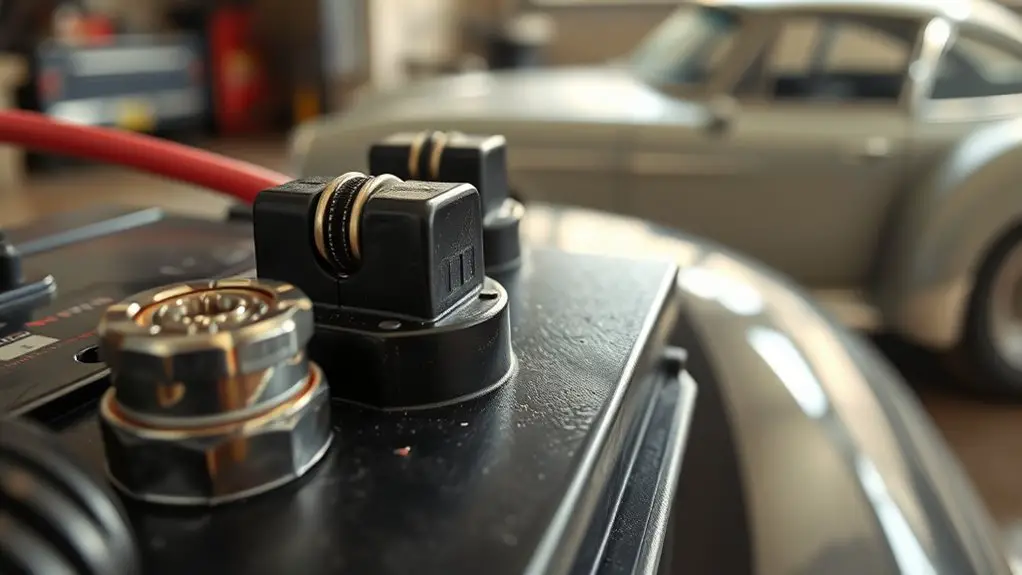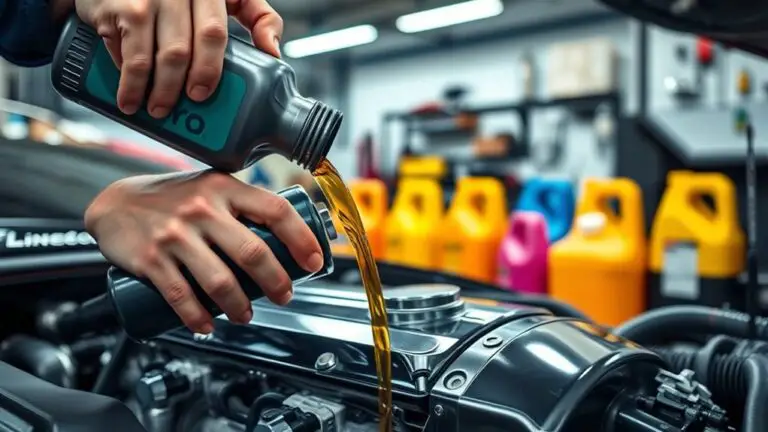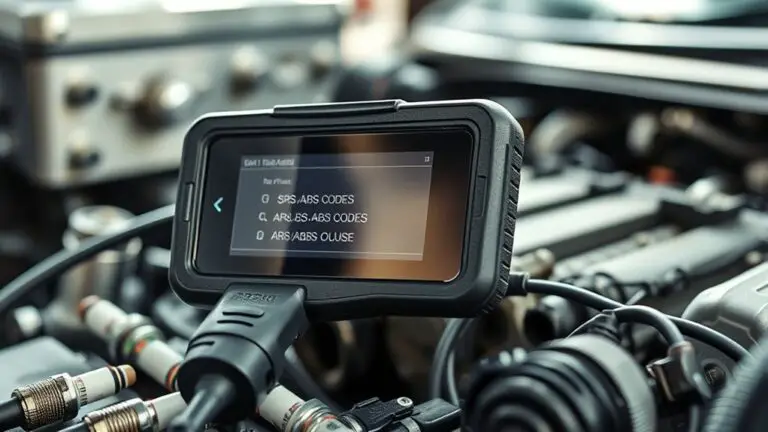Fuel and Battery Care to Stop Corrosion on Connectors for Long-Term Parked Cars
To protect fuel and battery systems during long-term parking, start by stabilizing the fuel and keeping the tank near full to minimize air and moisture. Use a proven fuel stabilizer per the label, store in clean, labeled containers, and monitor fuel quality regularly. For the battery, clean and dry terminals, disconnect negative first, inspect for corrosion, apply a protective coating, and reconnect in the reverse order with proper torque. Pair these with corrosion inhibitors and routine checks for best results, and you’ll reduce risks as you prep for the next drive.
Stabilizing Your Fuel for Long-Term Parking
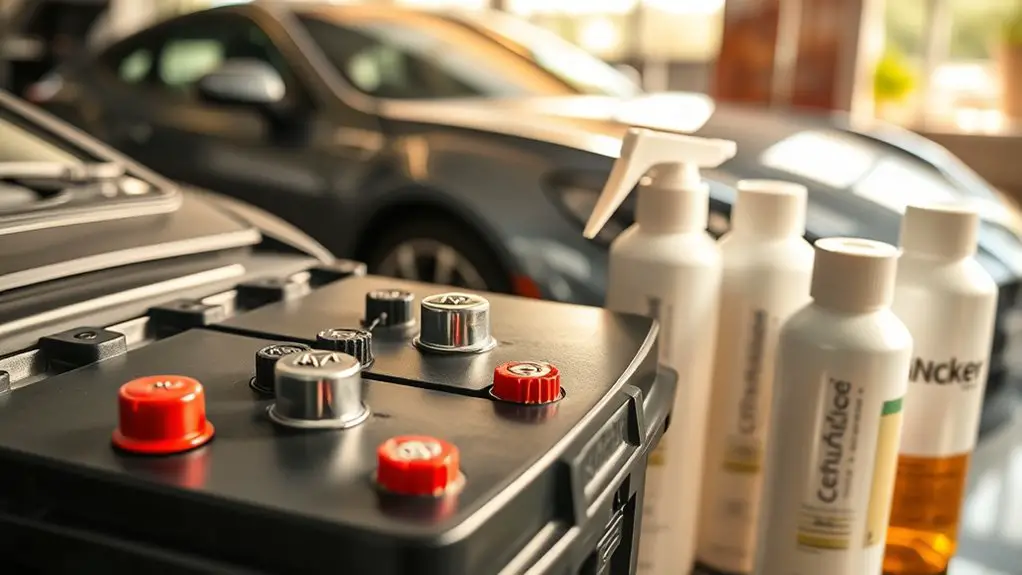
To stabilize fuel for long-term parking, start by filling the tank to at least 95% capacity to minimize air and moisture exposure. You’ll prevent oxidation and fuel degradation by reducing space for vapors. Next, add a proven fuel stabilizer according to the manufacturer’s dosage for your fuel type and tank volume. Stabilizers bind moisture and slow as well as halt gum formation, helping engines start later without varnish deposits. Choose storage containers that are clean, sealed, and compatible with gasoline or diesel, and always seal lids tightly after use. If you regularly store, consider a secondary containment approach to prevent leaks. Label containers with fuel type, stabilization date, and expiration window. Periodically rotate stock if you expect long-term storage. Keep caps vented only during pouring, and store containers in a cool, dry place away from heat sources. This approach supports freedom through predictable readiness and reliable starts.
How To; Clean and Dry Battery Terminals
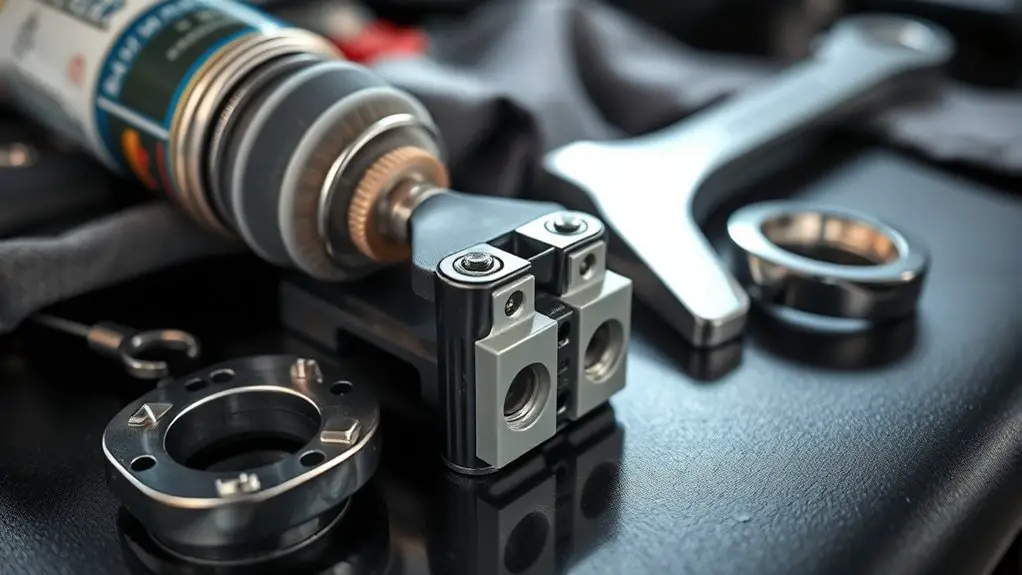
Clean and dry battery terminals prevent parasitic drains and starting failures. You’ll perform a controlled clean using minimal liquid, a nylon brush, and a non-abrasive cloth to avoid terminal damage. Begin by disconnecting the negative cable first, then the positive, ensuring tools don’t contact opposite terminals. Inspect for corrosion, white powder, or greenish buildup, which signals electrolyte leakage or electrolyte drying. For battery cleaning, apply an appropriate cleaner or a vinegar-based solution if needed, but avoid excessive moisture near vents. Rinse lightly and dry thoroughly with a lint-free cloth, allowing remaining moisture to evaporate before reconnection. Reconnect the positive terminal first, then the negative, and torque to manufacturer specifications to maintain a solid connection. After reassembly, apply terminal protection such as terminal grease or a corrosion-inhibiting spray to prevent re-oxidation. Regular maintenance reduces parasitic draw and extends long-term reliability for parked vehicles.
Choosing the Right Corrosion Inhibitors

Choosing the right corrosion inhibitors is a key step after cleaning and drying battery terminals, because the right product can prevent re-oxidation and parasitic drain without harming seals or venting systems. You should compare formulations designed for automotive terminals and connectors, prioritizing products that form a durable, electrically insulating film while remaining compatible with common gasket materials. Look for corrosion prevention techniques that specify corrosion inhibitors safe for aluminum and copper alloys, with low-volatile carriers to minimize vapor exposure in enclosed spaces. Ascertain the product is easy to apply evenly and supplies adequate coverage without pooling near seals. Avoid those that harden excessively or interfere with battery venting. Favor inhibitors labeled as moisture-activated or moisture-tolerant to maintain protection during humidity swings. Document their recommended reapplication intervals and storage conditions. Choose a product with clear instructions, traceable ingredients, and proven field performance to sustain long-term reliability.
Keeping Electrical Connectors Protected and Accessible
To protect connector surfaces, guarantee all contact areas are clean and free of debris before reassembly. Maintain accessible electrical paths by arranging cables neatly and keeping protective caps in place when connections aren’t in use. By minimizing corrosion risks through proper sealing and regular inspection, you preserve both performance and reliability.
Protect Connector Surfaces
Protecting connector surfaces is essential to maintain reliable charging and prevent corrosion, dirt ingress, and moisture from compromising contacts. You should apply robust connector coatings and select surface treatments that resist oxidation while maintaining electrical contact. Clean surfaces prior to any treatment, then seal with a compatible coating that tolerates temperature swings and humidity. Inspect seals and housings for wear, replacing degraded parts promptly to preserve accessibility. Avoid abrasive cleaners that could damage plating or coatings. Store connectors in a dry, dust-free environment and cover exposed interfaces when parked long term.
| Benefit | Implementation |
|---|---|
| Corrosion resistance | Use approved connector coatings |
| Dirt/moisture exclusion | Apply durable surface treatments |
Preserve Electrical Access
Preserving electrical access builds on keeping connector surfaces protected by ensuring that all connection points remain clean, dry, and readily reachable during parked periods. You maintain accessibility by organizing the engine bay and trunk area so you can inspect, test, and reseat connections without moving the vehicle. The focus is on practical electrical maintenance that minimizes corrosion risk while preserving function.
- Regularly inspect for loose or frayed cables, clean connector surfaces, and verify dust seals are intact.
- Use light, non-residual contact cleaner to perform connector cleaning, then dry thoroughly before reassembly.
- Schedule short, systematic checks that confirm accessibility of terminals, fuses, and plugs for fast re-connection.
This approach keeps electrical access reliable, straightforward, and freedom-friendly.
Prevent Corrosion Risks
Preventing corrosion starts with keeping connectors clean, dry, and shielded from exposure during parked periods. You assess every contact point for oxidation risk, then enforce a routine that minimizes moisture ingress and dust accumulation. Corrosion prevention hinges on selecting appropriate enclosure materials, ensuring seals remain intact, and maintaining a dry, stable environment around terminals. Regular inspections focus on terminal bolts, shielding, and wiring harness entries, with immediate corrective action at first signs of corrosion or leakage. You account for environmental factors such as humidity, temperature swings, and airborne contaminants that accelerate degradation. Implement protective coatings only where compatible with electrical performance, and avoid over-application that can trap moisture. Document findings, track preventive actions, and keep connectors accessible for quick testing and service.
Storage Practices to Minimize Rust and Gunk
To minimize rust and gunk during storage, establish a clean, dry, and stable environment: park in a shaded, well-ventilated area and keep the vehicle off the ground with a moisture-absorbing mat or raised platform. You aim for minimal exposure to humidity, dust, and contaminants, so implement containment and routine checks that preserve accessibility and function. Focus on rust prevention and gunk removal by limiting contact surfaces and maintaining dry, neutral conditions around connectors and undercarriage.
1) Prepare a breathable cover that fits loosely enough to vent moisture but keep debris out, and store the car with windows slightly ajar in dry conditions.
2) Inspect wheel wells, chassis, and battery tray every two weeks, removing any film or residue with a clean, non-abrasive cloth.
3) Use silica gel packs and a small dehumidifier in the storage area to sustain low humidity levels without emissions or odors.
Monitoring Fuel and Battery Health Over Time
You’ll assess fuel stability indicators to detect degradation and parasitic losses over time. Track battery health trends by monitoring resting voltage, cold-cranking amps, and state of charge drift to flag aging effects. Consider long-term corrosion risks that can impair connections, fuel lines, and storage hardware, and plan preventative checks accordingly.
Fuel Stability Indicators
Have you ever wondered how fuel stability changes as a car sits idle, and what that means for battery health over time? Fuel stability indicators help you read when fuel quality declines, which can indirectly affect starting reliability and corrosion risk. You’ll focus on practical markers and simple tests that reveal changes without disassembly, enabling proactive maintenance. Track trends across storage periods to anticipate aging effects and schedule stabilizers or draining decisions before it harms connectors or the battery.
- Fuel quality observations: color, odor, sediment, and phase separation clues.
- Stability tests: simple refractometer or test-strip checks for volatility and residue.
- Trend logging: note dates, temperatures, and storage duration to inform future preventive actions.
Battery Health Trends
Battery health trends track how stored fuel quality and vehicle electrical load interact over time, revealing correlations between fuel aging, battery stress, and starting reliability. You’ll observe gradual shifts in open-circuit voltage, resting current, and cranking performance as cycles accumulate. Health monitoring focuses on consistent data capture: voltage thresholds, state of charge, temperature, and load profiles during rest and attempted starts. Battery maintenance becomes a routine: schedule periodic tests, monitor electrolyte or cell balance if applicable, and verify alternator and parasitic draw are within spec. Trends highlight when preventive action is warranted—top-off with quality fuel, optimize long-term storage practices, and replace aging units before failures occur. Clear records support informed decisions, reducing downtime and extending system reliability during extended parkings.
Long-Term Corrosion Risks
Long-Term Corrosion Risks arise from prolonged exposure to environmental and operational factors that affect both fuel and battery systems. You’ll monitor how salt, humidity, temperature swings, and idle chemistry drive deterioration at connectors and seals, potentially reducing conductivity and reliability. The goal is to detect early signs and implement corrosion prevention measures before failures occur, preserving performance and safety during long-term parking. You’ll track fuel stability, electrolyte condition, and battery terminal health as part of a systematic maintenance plan, prioritizing noninvasive checks that don’t require full disassembly. Consistent practices protect circuits, minimize parasitic drains, and extend service life. Stay proactive with connector maintenance and fuel quality audits to sustain ideal electrical performance during extended dormant periods.
- Inspect seals, terminals, and insulation for signs of moisture ingress and galvanic wear.
- Schedule regular corrosion prevention steps, including cleaning and protective coatings appropriate for connectors.
- Log fuel and battery health data, and review trends to adjust maintenance intervals.
Restarting and Inspection Before Driving Again
When you’re ready to drive again, perform a careful restart and inspection to verify the vehicle is ready for operation. Begin with a controlled startup: verify key systems initialize normally, listen for abnormal sounds, and observe gauge indicators for stability. Conduct engine diagnostics by checking for error codes using your scanner if available, and address any warnings before moving. Verify fuel system integrity after long idle periods; confirm no leaks, vapors, or odors near the engine bay. Inspect battery connections for corrosion or looseness, and confirm terminal clamps are tight. Check fluid levels—engine oil, coolant, brake fluid, and transmission fluid—refill to manufacturer specifications if needed, and top off windshield washer fluid. Examine belts and hoses for signs of deterioration and proper tension. Finally, perform a cautious road test in a low-risk area to verify steering, braking, and suspension respond predictably, confirming all systems function within normal parameters before regular operation resumes.
Frequently Asked Questions
How Often Should I Check My Fuel Stabilizer Concentration in Parked Cars?
You should check your fuel stabilizer concentration every 6 months. This fuel stabilizer frequency helps prevent gum formation and keeps your engine ready. When you test, perform concentration testing with a clear reading tool and compare to the manufacturer’s recommended range. If it’s low, top up promptly and re-test after a month. Maintain a routine, log results, and adjust cycles to your usage pattern, ensuring ideal protection without overdoing additives.
Can Battery Corrosion Occur Without Visible White or Blue Residue?
Yes, battery corrosion can occur without visible white or blue residue. Invisible corrosion often forms beneath terminals or inside case hardware, compromising connections even when outward signs aren’t evident. You should perform regular battery maintenance, including terminal cleaning, terminal torque checks, and voltage tests, to detect hidden buildup. Use dielectric grease after cleaning to minimize future risk. Maintain a strict maintenance schedule, document findings, and address any gradual voltage drop promptly to prevent unexpected failures.
Do All Corrosion Inhibitors Require a Protective Sealant Afterward?
Yes, not all require a protective sealant afterward. Some corrosion inhibitors form a durable coating, while others need a sealant to extend life. You’ll want to assess product instructions and environmental exposure. For corrosion prevention, choose compatible sealant types if the inhibitor isn’t self-sealing. Apply systematically: prep surface, apply inhibitor, then sealant as directed. You’ll gain consistent protection and easier maintenance in demanding climates.
Will Heat From Sun Exposure Affect Corrosion Inhibitor Effectiveness?
Heat exposure can reduce corrosion inhibitors’ effectiveness over time. You’ll want to shield connectors from direct sun, encourage even cooling, and recheck seals after peak heat days. Heat exposure accelerates oxidation and can thin protective films, so reapply or replace inhibitors as recommended. Track ambient temps and daytime highs, not just average conditions, to gauge longevity. You’ll optimize protection by combining heat-aware scheduling with regular inspections and maintenance intervals for best long-term results.
Are There Signs of Hidden Fuel System Corrosion Beyond Terminals?
Yes, you can spot signs of hidden corrosion beyond terminals, but you’ll need a systematic scan of the fuel system. Look for rust-colored sediment, varnish, or grey/black deposits, and listen for unusual fuel odor or pressure drops. Inspect connections, hoses, clamps, and fuel rails for seepage or pitting. Use diagnostic tests to verify flow and integrity, and document any anomalies promptly to prevent performance loss or safety risks.

